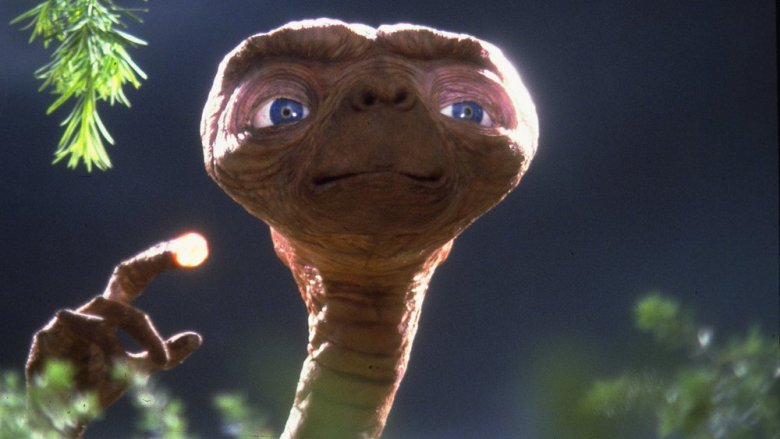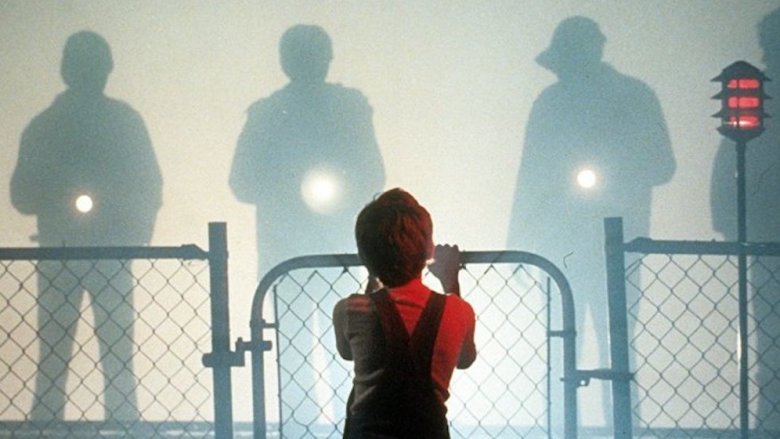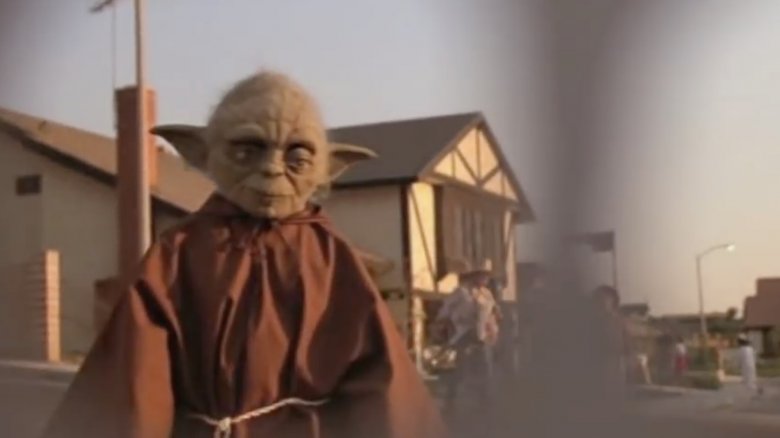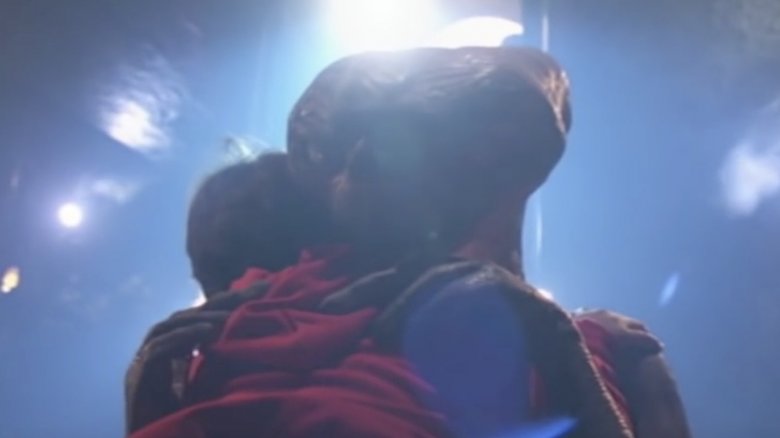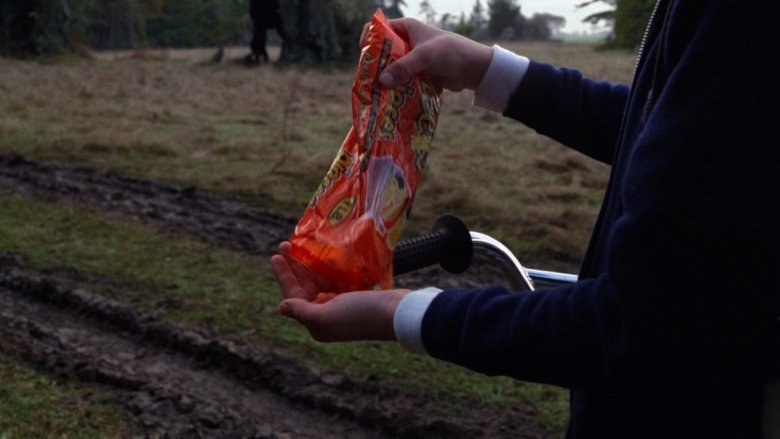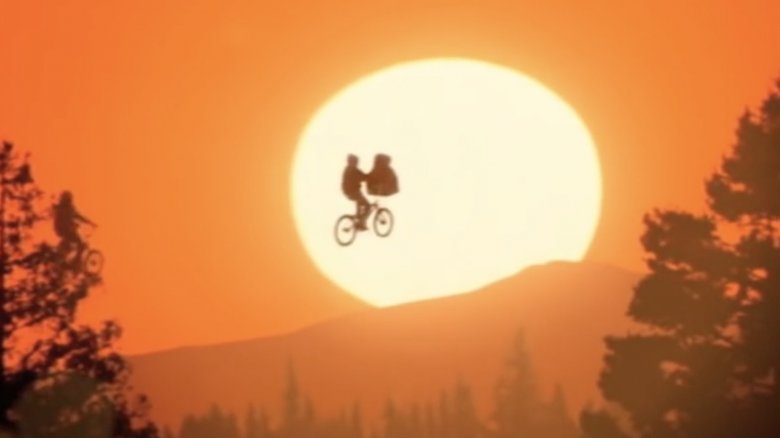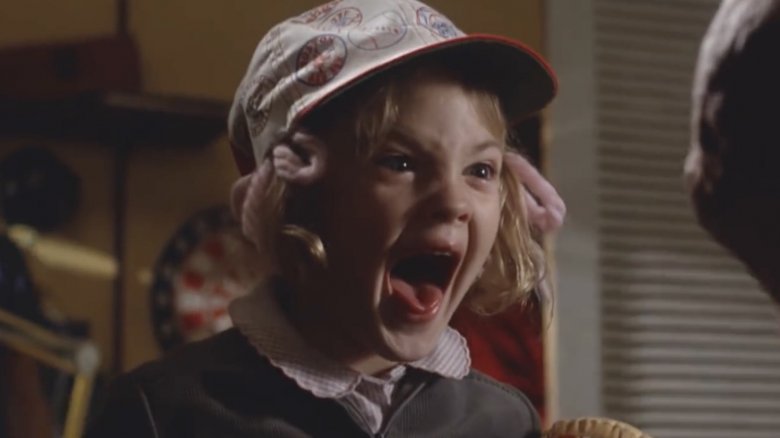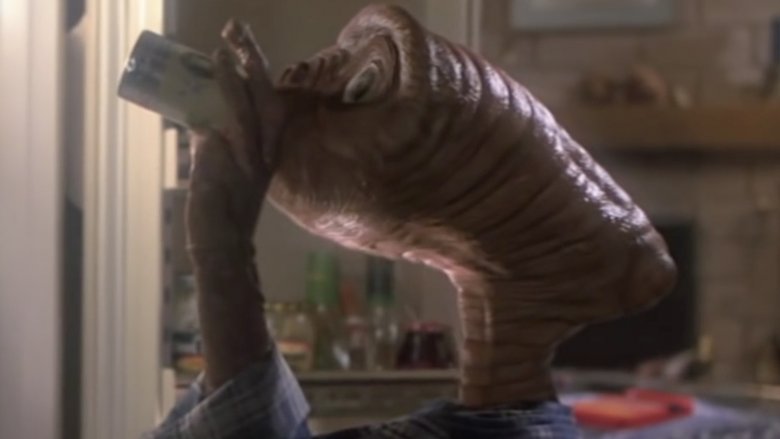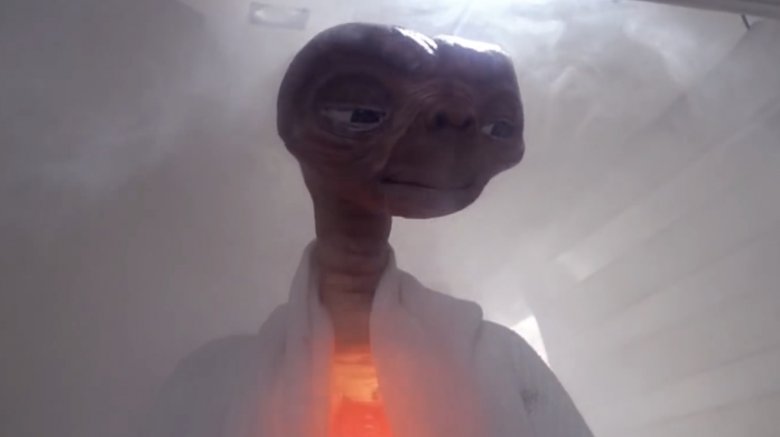Things You Only Notice In E.T. As An Adult
E.T.: The Extra-Terrestrial is a masterpiece of the movies — and one of the highest-grossing films of all time. It's a simple story — an alien lands in a generic suburb, a lonely little boy named Elliot (Henry Thomas) takes him in, and they establish a profound psychic and emotional bond. Elliot and his siblings (Robert MacNaughton and Drew Barrymore) help E.T. "phone home" to his planet of origin for a rescue, but first they have to make sure E.T. gets off of Earth without being obliterated by creepy government agents.
There's something for everyone in E.T. It's about kids, so kids just keep discovering it more than 35 years after its initial release. Adults like it, too, because it's a sensitively told emotional story with a little bit of comedy, adventure, action, and drama. However, kids who grow up and become adults may notice that E.T.: The Extra-Terrestrial is a little... different than they might remember. There are all kinds of details, great and small, that flew right over kids' heads like they were a mob of alien-protecting tweens on bikes. These are the things you only notice in E.T. as an adult.
No grown-ups allowed!
E.T.: The Extra-Terrestrial is a kids' movie. This isn't to say that it's a movie for kids (although it's appropriate for most any age), more that it is literally a movie full of kids. It's a look into Kid World: how kids react to divorce, how kids have their own secret suburban societies, how kids conceal and help a friendly alien visitor, and how kids fight a bunch of government spooks.
When watching this as a child, kids might not be totally aware that it's a big deal they're seeing themselves up on that screen, because it reflects their day-to-day: kids-only with just the occasional adult interruption. In fact, for most of the movie, the only adult face in the movie is that of Elliot, Gertie, and Michael's mother (Dee Wallace). Despite a lengthy classroom scene, audiences don't see Elliot's teacher's face, and then when adults do show up, they're mostly bad guys. To enhance the movie's completely childlike point of view, Steven Spielberg, the boy wonder of the movies, shot a lot of the film at a kid's eye level. That's some astonishing and deep-seated commitment to a theme.
Is E.T. from a long time ago in a galaxy far, far away?
Easter eggs are so named because they are semi-hidden, just like literal Easter eggs. And, like Easter eggs, they're often quite visible and obvious from an adult vantage point, but a little bit more difficult for those not schooled on the way movies work...like kids. Children get completely engrossed in a movie (especially one as enchanting as E.T.), and when a big movie in-joke comes along, they're more likely to take it at face value. E.T. has just that type of treat for movie fans.
During the film's trick-or-treating scene, Elliot gets E.T. out of the house by dressing him up like a ghost — in a sheet with eyeholes. From E.T.'s point of view, the audience sees kids pass by in costume as ghouls, goblins, and pop culture figures...including Yoda from the Star Wars movies. As E.T. and the kid Yoda briefly cross paths, E.T. excitedly shouts "Home! Home!" in regards to the swamp-dwelling Jedi legend. On one level, it's funny because E.T. thinks the kid is a real alien. On another, it suggests that E.T. knows Yoda, or that E.T. and Star Wars exist in the same film universe.
Didn't quite catch your name
Audiences learn so much about Elliot over the course of E.T.: The Extra-Terrestrial. He's about 11 years old, loves red-hooded sweatshirts, lives in the suburbs, has two siblings, his parents are divorced, and he can connect telepathically with an alien. As for that alien, it has a glowing finger and a light-up heart, wishes to go home, loves Reese's Pieces, can effectively hide amidst a pile of stuffed animals, can bring plants back to life, and can make bikes fly past government agents wielding guns (or, if it's the E.T. re-release, walkie-talkies).
And that's about all we know about Elliot and E.T. One thing that becomes clear upon viewing with jaded, nitpicky, adult eyes: neither Elliot's last name, nor E.T.'s real name, are ever given. Elliot and all the other kids call their magical alien visitor "E.T." — short for "extra-terrestrial" (which is a long word that these kids maybe wouldn't know). E.T. never tells his Elliot his real name. They can live in each other's minds, but a simple name exchange never occurs?
E.T. is an adorable, candy-loving, corporate shill
One of the most endearing scenes in E.T. occurs when Elliot fully befriends his little alien roommate by luring him out with a trail of well-placed Reese's Pieces. The gentle, telekinetic alien at the heart of E.T. just can't get enough of those candy-coated sweetened peanut butter gems. Yep — to a kid's eye, this seems like a cute and organic moment, because candy is extremely important to children, and they understand that sugar is a universal language that can unite even interplanetary species. To an even remotely savvy or cynical adult, however, E.T.'s love of Reese's Pieces is but a glaring, less-than-magical example of Hershey-approved product placement. It's a wonder E.T. didn't tell Elliott he needed to "phone home with AT&T." While the candy company was admittedly on the fence about playing up its ties to the movie, their million-dollar promotional gambit worked: E.T. was such a juggernaut that in the immediate wake of the film's success, sales of Reese's Pieces tripled.
We believe you can fly
It's one of the most spectacular and satisfying moments in movie history. As Elliot, his brother, and his brother's friends race their bikes to get a weakened E.T. (sitting in the basket on the front of Elliot's bike) back to his spaceship, they come across a roadblock of government agents that want to take E.T. away and do who knows what to him. It looks like our heroes are sunk...until E.T. uses his special powers to launch the whole bicycle contingent up into the sky and they fly away, all to the strains of John Williams' powerful score which can somehow still be heard over the audience's joyful weeping. The moon-backed silhouette of E.T. and Elliot on a bike is such an iconic image that director Steven Spielberg used it as the logo for his film production company, Amblin Entertainment. One problem: This scene kind of doesn't make any sense. If even a weakened E.T. has the power to make others fly, how come he never used that ability when he was at full strength? At any time, he could have flown back across town to his spaceship. Heck, he might even have been able to use that power to make himself a new spaceship.
It Drew you in
Revisiting beloved childhood movies has more appeal than just the nostalgia factor. We want to see if the movies we loved as kids "hold up" — are they legitimately good, or did we just like them because we were kids, and everything is good when you're a kid? That's in part because movies completely envelop kids. There's little discernment between "actor" and "character" — those people up on the screens are having a "real" adventure, because for the most part, kid don't know about moviemaking and suspension of disbelief until they're older. But watching as an adult, you're aware of the people behind the roles, and you recognize them from their other work. For example, only an adult will realize upon adult-aged viewing that adorable little Gertie is actually America's Sweetheart, Drew Barrymore, star of Charlie's Angels and The Wedding Singer. They might also realize that the classmate Elliot kisses (emboldened by E.T.'s psychic link-up) is future Baywatch star Erika Eleniak.
It's pretty salacious for a kids' movie
Movies about childhood used to be very different than they are today, because childhood itself used to be very different. Adults who were kids near the time E.T. was released will notice that the "regular average childhood" experienced by Elliot and his pals (until E.T. came around) is not like the regular average childhood of today. For example, these were some "free-range" kids — they got to ride all over town on their bikes and weren't supervised or micromanaged by parents, unlike today's normal practices of helicopter parenting, micromanaging, and schedule planning down to the minute.
Also, parents today have a variety of tools at their disposal by which they can monitor and control their kids' screen time, so their little ones may only view what's appropriate in terms of quality and quantity. Some stuff in E.T. wouldn't fly according to today's strict, often sheltering standards. This is a movie for children in which the beloved alien protagonist spends a lot of time home alone, where he gets drunk. Also, E.T. briefly dies. That's some harsh kid stuff, Spielberg.
What's a 'cintus supremus,' anyway?
Okay, the most famous insult from E.T. — which Elliot angrily throws at his brother, Michael — is easy enough to understand, an NSFW but acceptable-in-the-'80s homophobic remark that posits Michael has bad breath for a very particular and personal reason. A kid watching E.T. would interpret that the phrase is both impolite and crude, as it includes the word for male genitalia, and also because Elliot's mom gets very angry when Elliot says it at the dinner table. But that kid might not understand the "mechanics" of the epithet.
Other insults in E.T. levied by kids — as kids are wont to do — make no sense at all. Only when one is an adult and has never heard those words outside of E.T. do they realize that they're meaningless hogwash. Notably, Michael's friend Greg (K.C. Martel) calls Elliot a "cintus supremus." That's the spelling according to the subtitles, but that...isn't anything. Perhaps it's a bit of fake Latin, an enduring insult-slang phenomenon best embodied by the old chestnut "dorkus malorkus."
Let's face it: E.T. is terrifying
Kids have fewer preconceived notions than adults about the world around them, which makes them often much more accepting and open-hearted to those that are different. At least, that's one theme of E.T. — the kids love the little guy straightaway, and most of the adults want to capture him, run tests on him, or kill him. Here's the deal, though: Adults have every reason to be suspicious and terrified of E.T. because E.T. is actually grotesque. If the average adult, acting on the developed instinct to protect themselves and their family, came across something in the woods that looked like an E.T., they wouldn't give it hugs and Reese's Pieces — they'd run away screaming or burn down the forest so as to kill the E.T. He's a shriveled, waddling mass with huge, dead glassy eyes, not to mention he's got a long, bony finger that lights up and a heart that glows. The only sounds he can manage are raspy grunts. E.T. is downright frightening.
